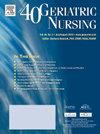The current status and influencing factors of oral frailty in elderly populations: A scoping review
IF 2.5
3区 医学
Q3 GERIATRICS & GERONTOLOGY
引用次数: 0
Abstract
Aim
In order to serve as a reference for future studies on oral frailty interventions, this scoping review aims to provide an analysis of the factors influencing oral frailty in elderly group.
Design
A scoping review based on the principles of participants, concept and context (PCC) and a theoretical framework of the Health Ecology Model (HEM).
Review methods
Based on the principle of PCC, this study reviews the prevalence and influencing factors of oral frailty.
Data sources
A systematic search was conducted across eight Chinese and English databases with time ranged from their foundation to March 10, 2024, using a combination of subject terms and free words. For the English database Web of Science, the search formula was: #1: TI = (aged OR elder OR elderly people), #2: TI = (Oral frail* OR Oral frailty OR oral weakness), #3: #1 AND #2. And manual searches were conducted using literature tracing methods for retrospective queries.
Results
A total of 25 papers were included, reporting a prevalence of oral frailty ranging from 9.5% to 59.2%. These papers identified 34 influencing factors categorized into four levels: individual characteristics level (such as age, gender, number of teeth, number of dentures, masticatory ability, swallowing ability, oral health, tongue pressure, dry mouth, periodontitis, medications, cognitive ability, physical frailty, nutrition, type of chronic diseases, cardiovascular disease, diabetes, cancer history, hemoglobin, albumin, BMI, Cystatin C), psycho-behavioral and lifestyle level (including depression, sleep quality, dietary habits, physical activity, smoking, alcohol, and oral health-related self-efficacy), interpersonal network level (social support, social isolation), and work and living level (income status, educational level, and type of residence).
Conclusions
The high prevalence of oral frailty in the elderly group worldwide is influenced by 34 factors, highlighting the importance of considering the synergistic effects of multiple influences. Meanwhile, the OFI-6 and OFI-8 are commonly used assessment tools for oral frailty research in the elderly, and each plays an important role. OFI-8 is a self-reported and subjective assessment scale that does not require specialized oral examination tool compared to OFI-6. As a result, it is better suited for rapid screening in community and outpatient settings than the OFI-6.
Impact
Generalizing the influencing factors of oral frailty facilitates a deeper understanding of its pathogenesis, enables the identification of high-risk groups, and provides a theoretical foundation for developing interventions aimed at preventing and mitigating oral frailty among the elderly.
Patient or public contribution
Not applicable.
老年人口腔脆弱的现状及影响因素:一项范围综述
目的分析老年人口腔虚弱的影响因素,为今后口腔虚弱干预措施的研究提供参考。设计一个基于参与者、概念和环境(PCC)原则和健康生态模型(HEM)理论框架的范围审查。综述方法根据PCC的原理,对口腔虚弱的发病情况及影响因素进行综述。数据来源对8个中英文数据库进行了系统检索,检索时间从数据库建立到2024年3月10日,使用主题词和自由词组合。对于英文数据库Web of Science,搜索公式是:#1:TI = (aged OR elder OR elderly people), #2: TI = (Oral虚弱* OR Oral脆弱OR Oral无力),#3:#1和#2。手工检索采用文献追溯法进行回顾性查询。结果共纳入25篇文献,口腔虚弱患病率9.5% ~ 59.2%。这些论文确定了34个影响因素,分为四个层次:个体特征水平(如年龄、性别、牙齿数量、假牙数量、咀嚼能力、吞咽能力、口腔健康、舌压、口干、牙周炎、药物、认知能力、体质虚弱、营养状况、慢性病类型、心血管疾病、糖尿病、癌症史、血红蛋白、白蛋白、BMI、胱抑素C)、心理行为和生活方式水平(包括抑郁、睡眠质量、饮食习惯、体育活动、吸烟、饮酒、与口腔健康相关的自我效能感)、人际网络水平(社会支持、社会孤立)、工作和生活水平(收入状况、教育水平和居住类型)。结论全球老年人口腔脆弱高发受34个因素影响,需要综合考虑多种因素的协同作用。同时,OFI-6和OFI-8是老年人口腔虚弱研究中常用的评估工具,各有重要作用。OFI-8是一种自我报告的主观评估量表,与OFI-6相比,不需要专门的口腔检查工具。因此,它比OFI-6更适合于社区和门诊的快速筛查。影响概括口腔虚弱的影响因素有助于深入了解其发病机制,识别高危人群,为制定预防和减轻老年人口腔虚弱的干预措施提供理论基础。患者或公众捐款不适用。
本文章由计算机程序翻译,如有差异,请以英文原文为准。
求助全文
约1分钟内获得全文
求助全文
来源期刊

Geriatric Nursing
医学-护理
CiteScore
3.80
自引率
7.40%
发文量
257
审稿时长
>12 weeks
期刊介绍:
Geriatric Nursing is a comprehensive source for clinical information and management advice relating to the care of older adults. The journal''s peer-reviewed articles report the latest developments in the management of acute and chronic disorders and provide practical advice on care of older adults across the long term continuum. Geriatric Nursing addresses current issues related to drugs, advance directives, staff development and management, legal issues, client and caregiver education, infection control, and other topics. The journal is written specifically for nurses and nurse practitioners who work with older adults in any care setting.
 求助内容:
求助内容: 应助结果提醒方式:
应助结果提醒方式:


